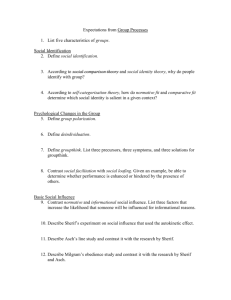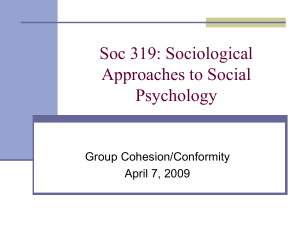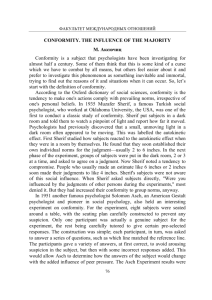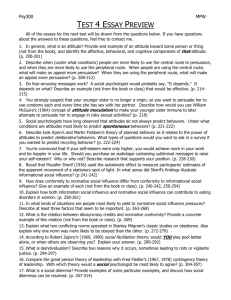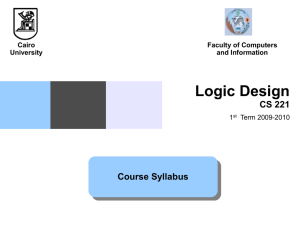Conformity Lesson 1
advertisement
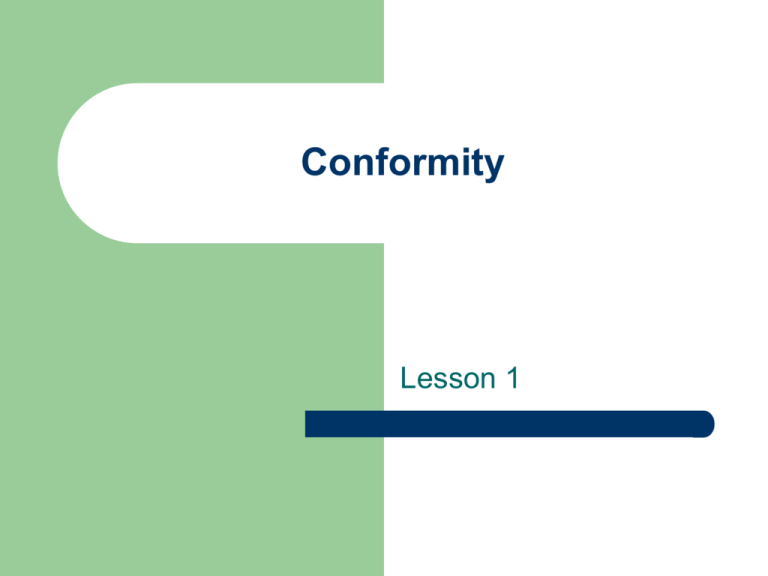
Conformity Lesson 1 Summary Questions 1. 2. 3. What is meant by social facilitation? Give an example of a dominant response? According to arousal theory, why does performance of a simple task in the presence of others result in facilitation? Exam Questions What is meant by a dominant response? (2 marks) Studies of social facilitation in animals can be explained by some theories but not by others. Identify one theory that can explain the effect and one that cannot. Explain your answer. (4 marks) Simon has just started to practice gymnastics at a local club. Two days ago he took part in his first competition. There was a large, noisy audience present and halfway through his performance, Simon forgot his routine. With reference to the information above, briefly discuss two psychological explanations for Simon’s poor performance in the competition. (4 marks) How many beans in this jar? What influences you? Conformity Conformity is a form of social influence where group pressure, real or imagined, results in a change in behaviour. Jenness (1932) The first informal experimental study of conformity where participants were asked to estimate how many beans the bottle contained. When asked for a group estimate they almost all changed their individual guesses closer to the group estimate. This persisted when asked again individually. They conformed. Research Study: Sherif (1935) Aim: Sherif wanted to investigate if people conform to group norms when they are in an ambiguous situation. Method: In this experiment a single point of light in a dark room seems to move as there is no point of reference (the autokinetic effect) but actually the light is perfectly still. Sherif put participants into the darkened room. He told them that a light would appear in front of them for almost an instant and then be extinguished. Then another light would appear and then be extinguished. He asked them to tell him how far the light had moved. However, the light had not moved at all, but because the participants had been asked the specific question “how far…” they assumed it had and gave a distance. It was found that individuals on their own in the room gave estimates about how much the light moved from about 2030cms or 60-80cms. The influence of group norms was investigated by Sherif putting three people in a room together. Sherif manipulated the composition of the group by putting together two people whose estimate of the light movement when they were alone was very similar and then one person whose estimate was very different. Each person in the room had to say aloud their estimate with the participant who had previously given the most different estimate last to speak aloud their answer.. Methodological Issues P C W I D D Results Sherif found that over numerous estimates of the movement of the light, the group would almost certainly converge. The person whose estimate was very different from the other two would conform to the other two in the group. Evaluation The significant difference between Jenness and Sherif’s study is that Jenness requested a ‘group answer’ whereas Sherif did not. The group size only included three people – some would argue this really isn’t a group. Ambiguous situation – there was no right or wrong answer – makes it difficult to draw conclusions about conformity, i.e. what would they do in an unambiguous situation? Also the fact Sherif said he would move the light was a leading question so they thought the light moved which is why they gave that answer. Any other methodological problems of laboratory experiments. Ethical considerations of deception, protection from harm, consent are especially easy to use here.
